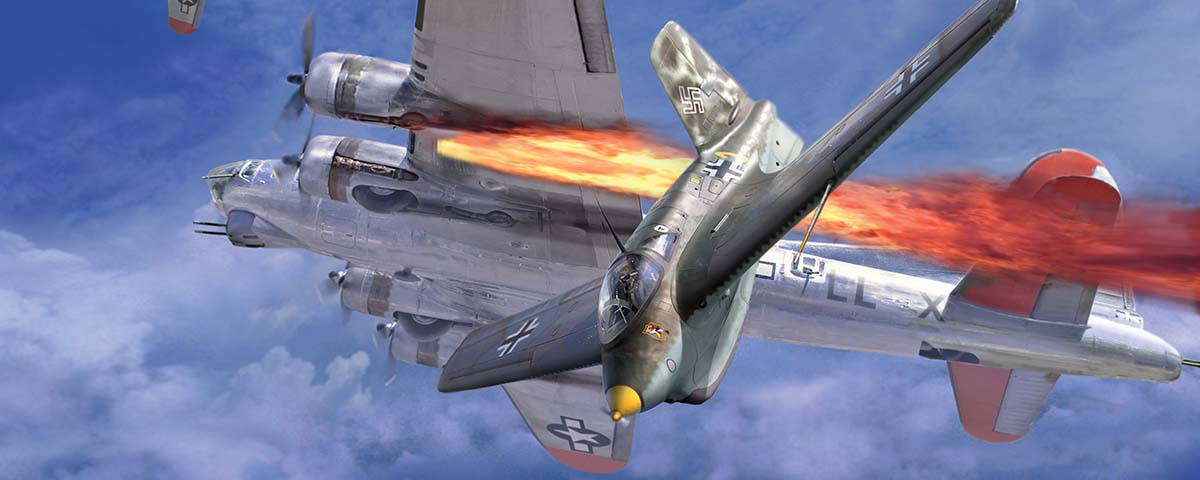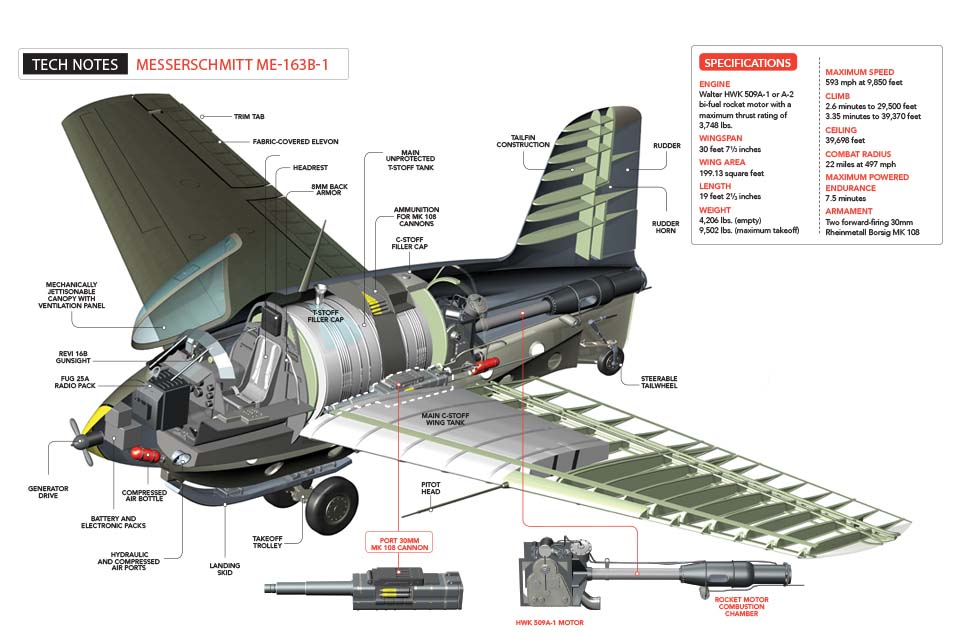The rocket-powered Me-163 Komet interceptor outperformed every other World War II combat aircraft…if its pilots lived to fight
In late July 1944, P-51 Mustang pilots who thought they flew the best fighter aircraft over Germany received a rude surprise.
Colonel Avelin P. Tacon Jr. of the 359th Fighter Group reported: “My eight ship section was furnishing close support to a Combat Wing of B-17s that had just bombed Merseburg….Someone called in contrails high at six o’clock.” From more than a mile above the Americans, two stubby, sweptwing single-seaters rocketed to the attack. As they slashed through his formation, Tacon recalled, “I estimate, conservatively, they were doing between 500 and 600 mph.” One dived away; the other climbed into the sun, as another 359th pilot put it, “like a bat out of hell.” That quickly, they were gone. “Although I had seen them start their dive and watched them throughout their attack,” Tacon admitted, “I had no time to get my sights anywhere near them.”
A loophole in the Versailles Treaty ending World War I had prohibited Germany from building fighters, but not sailplanes or rockets. In the 1920s and ’30s, designer Alexander Lippisch perfected tailless, delta-wing gliders, and engineer Helmuth Walter developed rockets burning 80-percent-pure hydrogen peroxide. This “T-Stoff” spontaneously ignited anything organic, and dissolved human flesh. “If you stick your finger in it,” Lippisch warned, “then you get only the bone out.”
Lippisch’s Messerschmitt Me-163A Komet was part rocket, part glider. Its plywood bat wings were swept back not so much for streamlining (transonic airflow being still little understood), but to put their control surfaces sufficiently rearward, like fins on a dart. “It just won’t spin,” declared test pilot Heinrich Dittmar. “A child can fly it.”
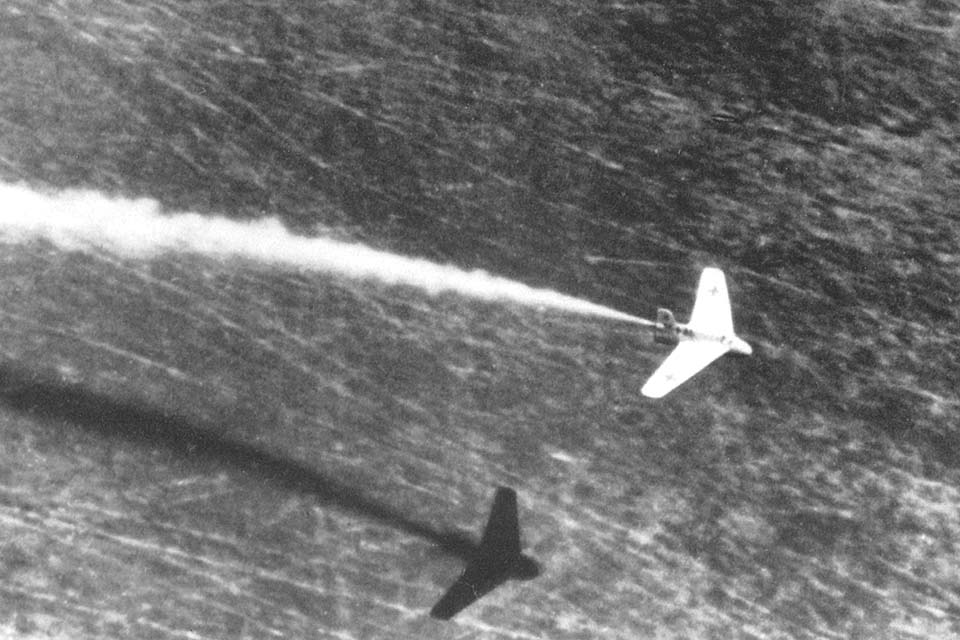
And it was fast. During one of the first unpowered glide tests, Dittmar hit 528 mph in a dive. On October 2, 1941, he was towed up over 13,000 feet, cast off and rocketed to 624 mph (about Mach .84) in level flight. “And then, things started to happen,” he recalled. “…The airplane was being pushed down by an incredible force. It took everything I had just to keep my hand on the stick….The engine quit!” Compression shockwaves (airflow over the wing exceeding Mach 1) had induced negative lift, killing fuel flow and speed. But Dittmar’s record, though top-secret, held for almost six years.
Lippisch was already working on a combat version, the Me-163B, with more fuel and wing guns. Walter designed a new motor burning T-Stoff with “C-Stoff,” 30-percent hydrazine hydrate solution in methanol. While big, conventional prop-driven fighters made do with about 2,000 hp, at low level the little rocket interceptor would employ the equivalent of 4,500 hp, and in thin upper air, up to 9,000 hp. However, shortages of C-Stoff and reliability issues—flameouts, explosions—would delay deliveries of the “Hell Machine” by a year.
Training for rocket fighters was unlike that for any other aircraft. Ascents were so rapid that pilots, in their unpressurized cockpits, got a touch of the bends as nitrogen bubbles formed in their bloodstreams. Diet was restricted to reduce intestinal gas, lest they blew up like balloons. Because pilots dropped their main wheels soon after takeoff to save weight and their rockets burned out in minutes, they learned to glide back to base and land on a belly skid. On one flight Dittmar came down too hard, injured his back and was grounded for two years. He was lucky. If, in a crash, leaking T-Stoff touched C-Stoff, detonation was instantaneous and total. Me-163 pilots quickly became experts at dead-stick landings, or they died.
In late 1943, test-unit commander Captain Wolfgang Späte, a prewar gliding champion and 80-victory ace, flew the first production Me-163B, noting, “Now I was about to find out what the Walter engine and my little Me-163 actually had in them.” In 3½ minutes the Komet could hit 40,000 feet. “This was a special kind of airplane,” Späte realized, “…an extremely good feeling aircraft, an elegant, lightning fast, easily controllable dart….You really could intercept any other aircraft with this bird.”
However, its Walter motor was nowhere near perfected. Späte was nearly killed when he ruptured a fuel line on takeoff, lost power and abandoned ship in mid-roll, tumbling off its wing. “It was unthinkable,” he wrote, “to consider sending a single airplane that had such an unreliable engine into combat, let alone deploying an entire squadron.”
Nevertheless, that spring the training unit was redesignated Jagdgeschwader 400 (JG.400). Test pilot Captain Rudolf “Rudi” Opitz delivered one of the first combat aircraft to the fighter wing. “When I zeroed in on [the] field for a high-speed low-pass, long strings of tracer bullets came at me from all sides,” he said. Local flak crews had never seen anything like the Komet, and they found it a hard target. “…We took it as a good omen that they had not achieved a single hit at the aircraft.”
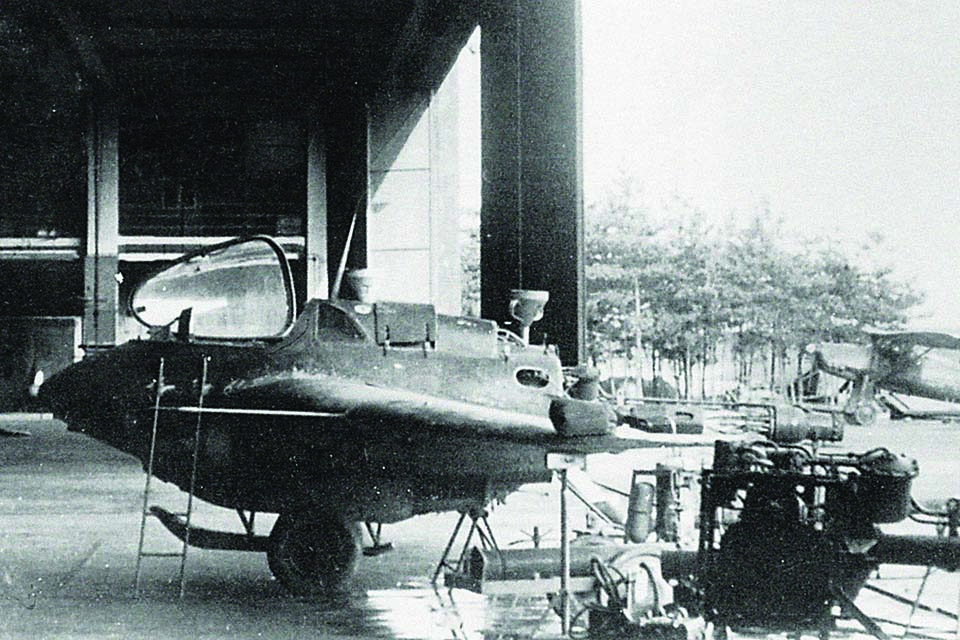
In May, Späte’s ground crew presented him with a rocket fighter painted completely in Richthofen red. He was not amused: “When I tried to make it back to the airfield, gliding without a drop of fuel left, I would be easy to see from miles away.” As luck would have it, early that afternoon four Allied fighters approached. In minutes Späte rose up under them, but as he adjusted his climb angle, he added a touch of negative g. His rocket promptly cut off. A midair relight required two minutes. As the drifting rocket plane slowed, the Americans, having apparently not spotted the little red bat-wing behind them, pulled away. By the time Späte re-fired the burner, he had to hurry to catch up, so much so that his Komet came up against the sound barrier, forcing him to break off his attack. “I’m more than curious to know,” he later mused, “whatever happened to those pilots who possibly owe their lives to the fact that there was no Mach warning device [in the Me-163].”
To protect critical synthetic fuel and rubber plants, JG.400 flew out of Brandis, a bomber field east of Leipzig. At that point in the war, few bomber raids pressed so deep into Germany. When they did, Komet pilots quickly learned the one maneuver they hadn’t sufficiently practiced: air-to-air combat intercepts. Even a tail chase meant closing speeds of nearly 350 mph and just a split-second to pull the trigger. “There just wasn’t enough time to get off a well-aimed shot,” Späte learned. “Whenever our pilots got a chance to fire, they were either still out of gun range or were already too close.”
And agile as it was, the Komet was too fast for dogfighting. A rocket pilot’s best tactic was to deny combat. The day after Colonel Tacon’s inconclusive July 1944 tangle, Captain Arthur J. Jeffrey of the 479th Fighter Group, leading four P-38J Lightnings, spotted a Komet attacking a crippled B-17 at 11,000 feet. “I closed with him and opened fire, observing strikes on the Me 163,” Jeffrey reported. “…He rolled over and went straight down, with me fire-walled behind him.”
His wingman, Lieutenant Richard G. Simpson, confirmed: “The Me 163 went into the clouds, which were at around 3,000 ft, still in a dive of 80 degrees or better. He must have been indicating 550-600 mph, and showed no signs of pulling out. I don’t see how the German could have gotten out of that dive.”
Jeffrey claimed a probable and was famously awarded the first rocket-fighter kill of the war, though there are no surviving Germans records of a Komet being lost that day. Even with its engine off and tanks empty, the sleek 163 could out-plummet Allied fighters diving on full power and, with its big bat wings, pull out later, too. As Lieutenant Hartmut Ryll put it: “Our bird hangs in there, steady as a rock. The Americans break off their attack relatively early. And by the time the airspeed dissipates back out of the 900 km/h [560 mph] area, you’re already back in the local area and under the protection of our own flak.”
On August 16, Ryll so badly shot up a 305th Bomber Group B-17 that, though it would struggle back to England, he was credited with a kill. Next he homed in on a lone Fortress of the 91st BG, but the escorting 359th’s Lt. Col. John B. Murphy cut him off. “I opened fire from about 1,000 feet and held it until I overshot,” Murphy reported. “I scored a few hits on the left side of the fuselage.”
Wingman Lieutenant Cyril W. Jones Jr. got in a burst, too. “The entire canopy seemed to dissolve on the enemy aircraft…the pilot was surely killed.” As the Komet spiraled down, Murphy turned back inside it, “seeing continuous strikes the full length of the fuselage. Parts began falling off, followed by a big explosion and more parts falling off. I could smell a strange chemical fume in my cockpit as I followed through the smoke from the explosion.” Ryll did not survive.
Eight days later Sergeant Siegfried Schubert and Lieutenant Hans Bott led two pairs of Komets up past 36,000 feet, shut off their rockets and dived a mile to attack a group of more than 1,300 B-17s and B-24s. Schubert targeted the leader of a 92nd BG formation, shooting up its left wing. It fell out of formation and would not return to base. Bott took on another Fortress, noting: “As soon as I began firing my MG 151 machine cannons one of them jammed but the other continued to fire and I saw my shells hit the aircraft.” Flak crews witnessed the bomber’s crash. Bott had been airborne just seven minutes.
Meanwhile Schubert’s dive had put him in the critical Mach zone. To bleed off speed, he pulled up in front of the 457th BG and came back down from 12 o’clock high. His head-on pass produced few hits, but Schubert looped back again for a tail attack, and with just three rounds reportedly shot off a B-17’s tail section.
It would be the rocket fighters’ finest hour. “After that, we experienced a series of failures and aircraft losses,” remembered Späte. “…The 7th of October was a terrible day of desperation!” At noon on that day Schubert and Bott led as many as 20 Komets in a mass scramble. Bott blew a five-foot section out of a 95th BG Fortress’ right wing and would claim it as a kill. Then Schubert made another head-on pass, and with time for just one burst, he made it count. A B-17 spun down, shedding six parachutes. Schubert’s third kill made him the leading rocket-fighter pilot of the war.
He and Bott landed at Brandis to take off in fresh Komets. “Halfway along the runway, the engine in Schubert’s aircraft cut out,” remembered another pilot, “and he rolled onto the grass to get out of the way of the other aircraft which were following him. One of his wings touched the ground and his aircraft somersaulted and then exploded just as the aircraft flown by Bott passed him.” Two more Me-163s crashed on landing, with another pilot killed.
Efforts were ongoing to solve the rocket fighter’s lack of endurance and firepower. That month, a spare 163A received underwing racks with two-dozen unguided R4M rockets—a rocket-firing rocket—but they offered no improvement in range, trajectory or explosive power over 30mm cannons. More promising was the Jägerfaust, the “fighter fist,” 10 recoilless 50mm wing cannons automatically firing upward when the Komet passed under a bomber. The force of the simultaneous volley initially blew off the 163B’s canopy, so a sequential delay was built into the trigger system. Meanwhile Walter was working on a new rocket with comparatively long-range cruise capability. It was to be fitted into the stretched-fuselage Me-163C, but that was passed over in favor of the even more advanced Me-163D with retractable wheels, and finally the Me-263 with cruise rocket, landing gear and pressurized cockpit. However, only three prototypes were complete by war’s end.
When Germany invaded Russia, the Soviets stepped up their own rocket-fighter program. Their Bereznyak-Isayev BI was of more conventional layout than the Komet, but its rocket, burning kerosene and red fuming nitric acid, was no more reliable and contributed to airframe corrosion. One pilot was slightly injured in a motor explosion and another killed in a crash when he lost control near the sound barrier. The BI never saw combat. Like the Germans, the Russians became more enamored of jets.
Rocket fighters also appealed to Germany’s B-29-beset allies, the Japanese. Though various plans and components were lost in transit aboard sunken U-boats, they developed their own license-built Komet, the Mitsubishi J8M1 Shusui (“Powerful Sword”). On its first powered test in July 1945, however, the prototype’s engine cut out and it crashed, killing the pilot.
Winter 1944-45 saw little action for JG.400. The Americans had learned that to avoid rocket fighters, they merely had to avoid Brandis. Späte deployed squadrons to outlying bases, but they were soon overrun by advancing Allied ground forces. And Germany’s sole C-Stoff plant had been obliterated. “Our only supply…is what’s left in storage at the different airfields and depots,” Späte was told. “We have enough here at Brandis for about another 50 fully loaded flights.”
Little fuel meant little flying or training. On February 22, 1945, more than 1,400 bombers pounded targets around Brandis, but only seven Komets were available to counter the threat. None of their pilots so much as engaged the enemy. Combat missions were subsequently limited to lone Allied reconnaissance aircraft; the Me-163B was one of the few German planes that could, and did, catch RAF Mosquitos in level flight. Finally, the toll in pilots having far outweighed their results—and with many more planes and pilots lost to accidents than to enemy action—Germany ceased Komet production after 364 had been built. Less than a quarter ever saw fighting.
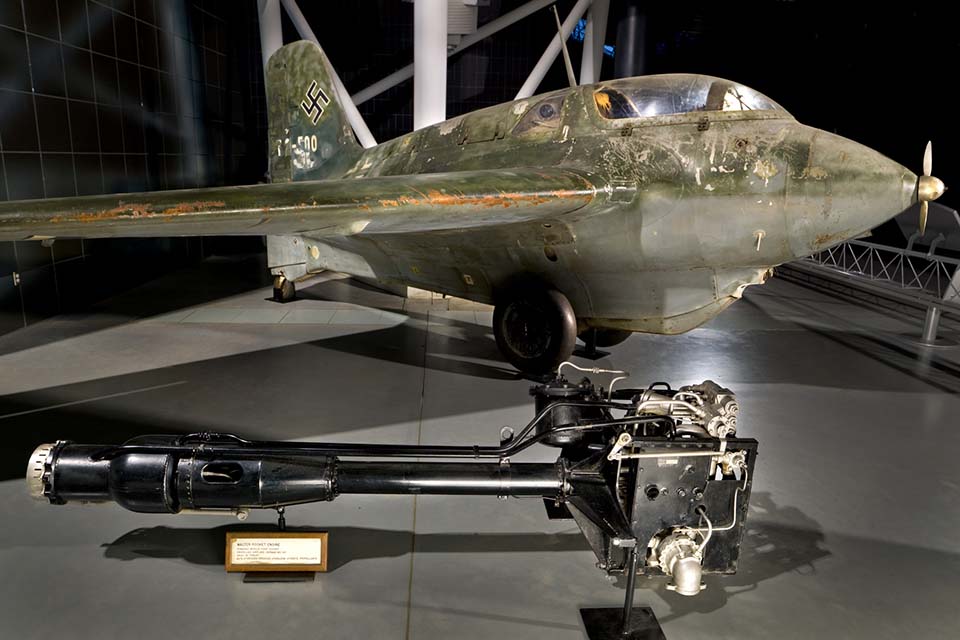
Before the end, Lieutenant Fritz Kelb dared to fly a Komet equipped with the 50mm Jägerfaust. On the evening of April 10, Brandis personnel watched him speed up under 100 bombers attacking Leipzig. “Kelb approached the lead aircraft of the bomber formation and flew by underneath the bomber at very close range,” Späte remembered. “At that instant, the bomber disappeared in a cloud of smoke and flames.” Jumped by Mustangs, Kelb put the Komet’s nose down and ran for home. “He had received a lot of hits on the top side of the airplane…shrapnel from the giant explosion which had blown his target to bits. This was the one and only time that this weapons system was used in the air….‘Too late!’”
That month JG.400 was disbanded. To this day their Me-163 Komet remains the only rocket-powered combat aircraft. Its pilots—those who survived—had the satisfaction of knowing they flew the hottest bird in the sky. In the final weeks of the war, B-17 pilot Edward F. Reibold was startled to find a rocket fighter flying off his wing, just out of machine-gun range. “Without changing direction, he slid into within a few feet of our left wing tip,” the bomber pilot remembered. “We were, at the time, traveling at an airspeed of approximately 285 mph. The pilot of the German plane hesitated off our wing, nodded, threw us a ‘Highball,’ pushed his throttle forward and accelerated forward in flight leaving us ‘standing’ in mid air.”
“They were all filled with an intractable urge to serve their Fatherland in a special way,” remembered Späte of his pilots. “…They were ready to give their lives in order to fulfill their dream of flying in a rocket.”
For additional reading, frequent contributor Don Hollway recommends: Komet: The Messerschmitt 163, by Jeffrey L. Ethell; and Jagdgeschwader 400: Germany’s Elite Rocket Fighters, by Stephen Ransom and Hans-Hermann Cammann. More info, images and video at donhollway.com/me-163. Click here to read about the Luftwaffe’s other rocket fighter, the Bachem Ba-349 Natter.
Bat out of Hell originally appeared in the November 2017 issue of Aviation History. Subscribe today!
To build your very own Me-163 Komet click here!

